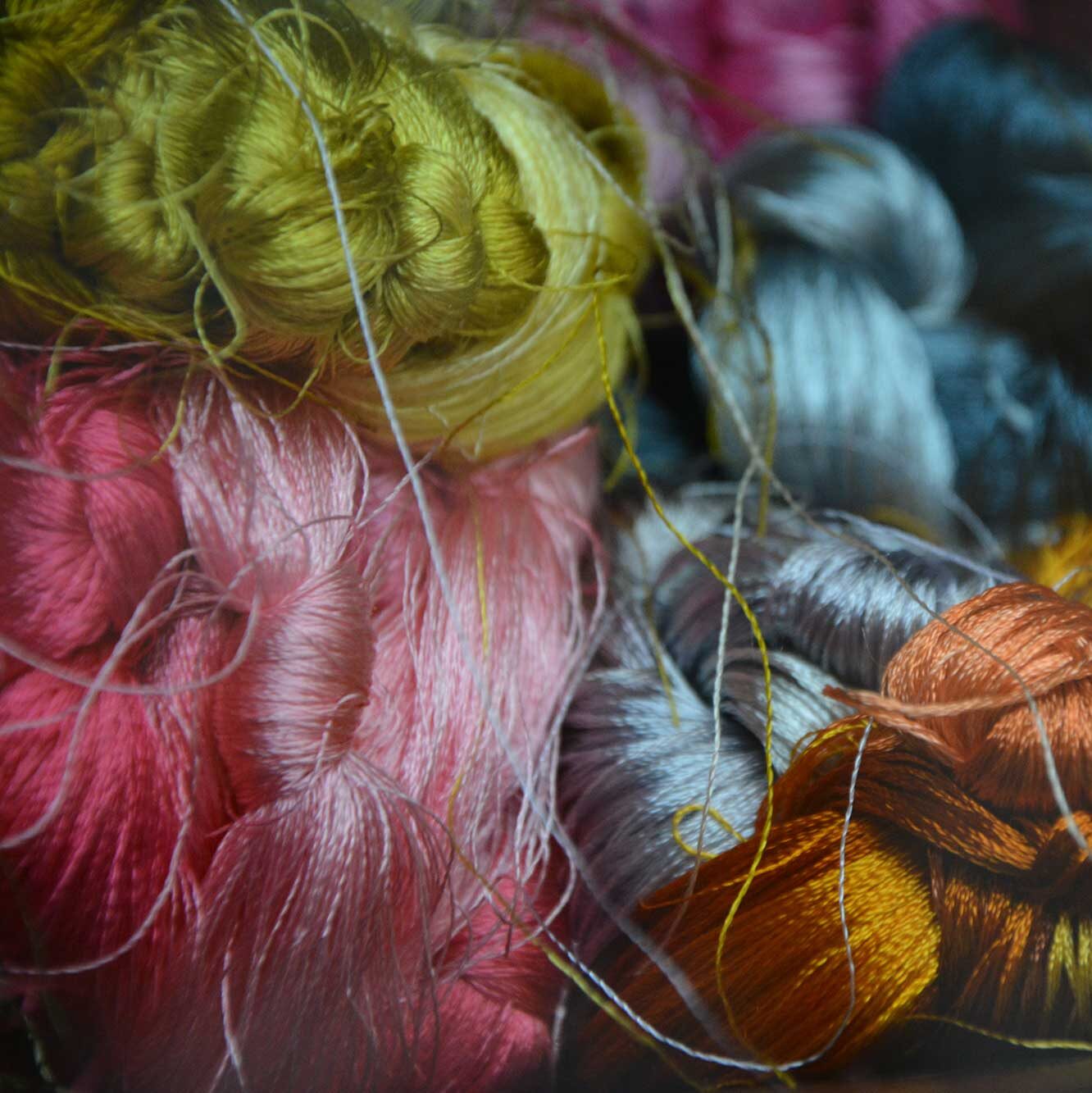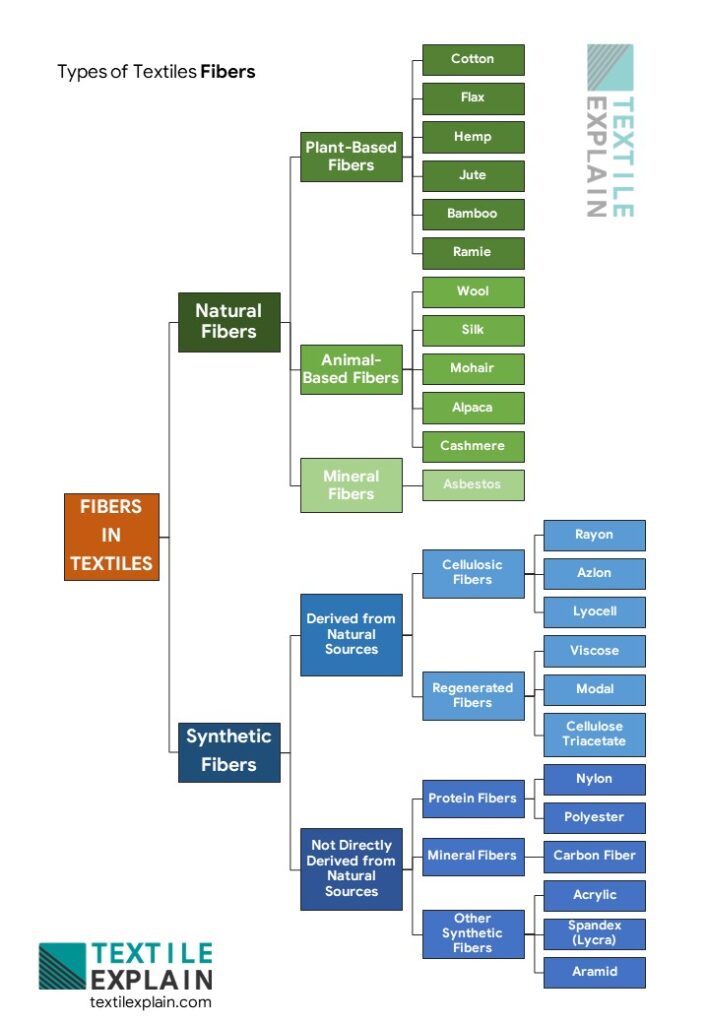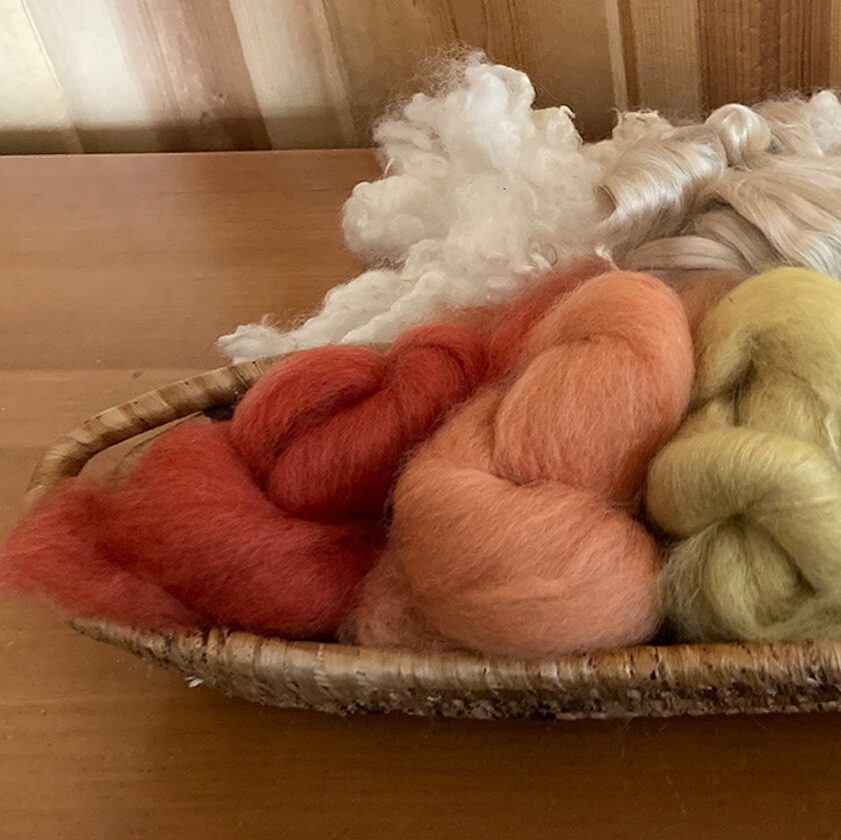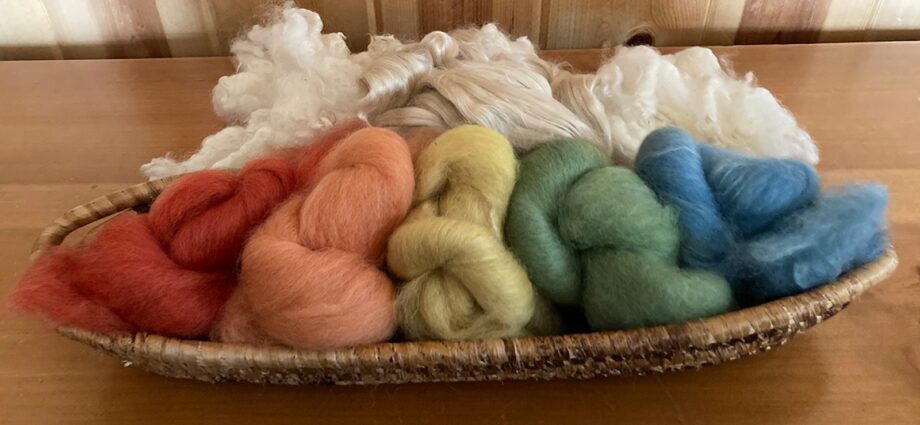What is Fiber
Fiber has different meanings depending on the context. It’s crucial to recognize the broader spectrum of fibers that exist for diverse purposes. While we focus on those used in textiles, various other fibers serve roles in construction, technology, and more.

What is Textile Fiber
Textile fibers are materials that are used to create textiles, which are fabrics or cloths. These fibers can be natural or synthetic and are the building blocks of fabrics. Textile fibers are either spun into yarn and then woven or knitted into fabric, or they can be directly formed into non-woven fabrics.
Types of Textile Fiber
Fibers, categorized by source, composition, and application, exhibit diverse properties crucial for textile innovation. Ranging from traditional to modern, these fibers form the backbone of textile development. Here are some common types.

Natural Fiver
Natural fibers are fibers that come from plants, animals, or minerals and are used to make textiles. These fibers are obtained directly from nature and can be either plant-based or animal-based. There is three type of natural fiver.
- Plant Based Fiver
- Animal Based Fiver
- Mineral Fibers

Plant Based Fiver
Plant-based fibers, also known as vegetable or cellulosic fibers, are derived from the cell walls of plants. These fibers are composed of cellulose, a complex carbohydrate. Plant-based fibers are often used to create breathable and comfortable textiles. We have several types of Plant Based Fiver.
- Cotton:
- Cotton is a soft, fluffy fiber that grows in a protective case, known as a boll, around the seeds of the cotton plant. It is a highly versatile fiber with moisture-wicking properties, making it comfortable for warm weather. Cotton is easy to dye, and its fibers can be spun into a variety of yarns, making it suitable for a wide range of garments.
- Cotton is a soft, fluffy fiber that grows in a protective case, known as a boll, around the seeds of the cotton plant. It is a highly versatile fiber with moisture-wicking properties, making it comfortable for warm weather. Cotton is easy to dye, and its fibers can be spun into a variety of yarns, making it suitable for a wide range of garments.
- Flax Linen:
- Linen is derived from the fibers of the flax plant. It is known for its exceptional breathability and ability to absorb moisture, making it a popular choice for warm-weather clothing. Linen fabrics have a crisp texture and a natural luster that gives them a timeless and classic appearance.
- Linen is derived from the fibers of the flax plant. It is known for its exceptional breathability and ability to absorb moisture, making it a popular choice for warm-weather clothing. Linen fabrics have a crisp texture and a natural luster that gives them a timeless and classic appearance.
- Hemp:
- Hemp fibers come from the stalk of the hemp plant. Hemp is recognized for its strength and durability, making it suitable for a range of products, including clothing, accessories, and even construction materials. Hemp cultivation requires minimal pesticides and water, contributing to its reputation as an eco-friendly and sustainable crop.
- Hemp fibers come from the stalk of the hemp plant. Hemp is recognized for its strength and durability, making it suitable for a range of products, including clothing, accessories, and even construction materials. Hemp cultivation requires minimal pesticides and water, contributing to its reputation as an eco-friendly and sustainable crop.
- Jute:
- Jute fibers are obtained from the stem of the jute plant. Known for their coarseness and natural golden color, jute fibers are commonly used to produce burlap, hessian, and other coarse fabrics. Jute is a biodegradable and environmentally friendly fiber, and it finds applications in packaging, textiles, and home furnishings.
- Jute fibers are obtained from the stem of the jute plant. Known for their coarseness and natural golden color, jute fibers are commonly used to produce burlap, hessian, and other coarse fabrics. Jute is a biodegradable and environmentally friendly fiber, and it finds applications in packaging, textiles, and home furnishings.
- Bamboo:
- Sourced from the pulp of bamboo plants, bamboo fibers are celebrated for their sustainable nature, natural antibacterial properties, and softness.
- Sourced from the pulp of bamboo plants, bamboo fibers are celebrated for their sustainable nature, natural antibacterial properties, and softness.
- Ramie:
- Ramie fibers come from the Chinese nettle plant. Similar to flax and linen, ramie fibers are known for their strength and durability. Ramie fabrics are resistant to wrinkles and mold, making them easy to care for.
Animal Based Fiver
Animal fibers are natural fibers that are derived from animals. These fibers can come from the fur, hair, or secretions of animals, and they are used in the production of textiles and fabrics. Animal fibers are known for their unique characteristics, such as warmth, softness, and often a luxurious feel. Common examples of animal fibers include:
- Wool:
- Wool comes from the fleece of sheep or other animals like goats (cashmere and mohair), alpacas, and rabbits (angora). It is known for its warmth, softness, and natural elasticity.
- Wool comes from the fleece of sheep or other animals like goats (cashmere and mohair), alpacas, and rabbits (angora). It is known for its warmth, softness, and natural elasticity.
- Silk:
- Silk is produced by silkworms and is known for its smooth texture and luxurious appearance. It is commonly used in high-end garments.
- Silk is produced by silkworms and is known for its smooth texture and luxurious appearance. It is commonly used in high-end garments.
- Mohair:
- Mohair comes from the hair of the Angora goat. It is lustrous, silky, and often used in the production of luxurious fabrics.
- Mohair comes from the hair of the Angora goat. It is lustrous, silky, and often used in the production of luxurious fabrics.
- Alpaca:
- Alpaca fibers are derived from the fleece of the alpaca, a South American camelid. They are soft, lightweight, and hypoallergenic.
- Alpaca fibers are derived from the fleece of the alpaca, a South American camelid. They are soft, lightweight, and hypoallergenic.
- Cashmere:
- Cashmere is obtained from the soft undercoat of certain breeds of goats. It is prized for its softness and warmth.
Mineral Fibers
Mineral Fibers are naturally occurring fibers sourced from minerals or geological deposits. They are durable, heat-resistant, and find diverse industrial applications in construction and manufacturing.
- Asbestos Fiber:
- Asbestos is a naturally occurring mineral found in rocks and soil. It consists of thin and fibrous crystals. Historically used in construction materials for insulation, roofing, and various industrial applications.
— Note: Many countries have restricted or banned the use of asbestos due to its associated health hazards.
- Asbestos is a naturally occurring mineral found in rocks and soil. It consists of thin and fibrous crystals. Historically used in construction materials for insulation, roofing, and various industrial applications.
Synthetic Fibers
Synthetic fibers are man-made materials created through chemical processes, offering versatility and engineered properties such as strength and durability. Synthetic Fibers can be categories in the following way.
Derived from Natural Sources:
Cellulosic Fibers
Cellulosic fibers within the synthetic category are derived from natural sources, typically plant-based, and undergo chemical processing to create versatile and comfortable materials. Example
- Rayon:
- Recognized for its softness and breathability, rayon is produced from wood pulp. It has properties that make it comfortable to wear and is commonly used in clothing and textiles.
- Recognized for its softness and breathability, rayon is produced from wood pulp. It has properties that make it comfortable to wear and is commonly used in clothing and textiles.
- Azlon:
- Derived from proteins, azlon fibers have characteristics that make them resemble natural fibers, offering a unique blend of comfort and functionality.
- Derived from proteins, azlon fibers have characteristics that make them resemble natural fibers, offering a unique blend of comfort and functionality.
- Lyocell:
- Known for its environmental sustainability, lyocell is produced from wood pulp using a closed-loop process. It combines the comfort of natural fibers with eco-friendly production methods.
Regenerated Fibers
Regenerated fibers in the synthetic realm involve processes where natural materials, often cellulose, are broken down and reconstituted into new fibers. Common regenerated fibers are,
- Viscose:
- Versatile and widely used, viscose is derived from wood pulp. It is known for its softness and draping qualities, making it a popular choice in the textile industry.
- Versatile and widely used, viscose is derived from wood pulp. It is known for its softness and draping qualities, making it a popular choice in the textile industry.
- Modal:
- Modal is a soft and smooth fiber, similar to cotton but with enhanced durability. It is often used in clothing where a luxurious feel and good drape are desired.
- Modal is a soft and smooth fiber, similar to cotton but with enhanced durability. It is often used in clothing where a luxurious feel and good drape are desired.
- Cellulose Triacetate:
- Resistant to wrinkles and shrinking, cellulose triacetate is often used in apparel. It combines the benefits of natural fibers with improved durability and performance.
Not Directly Derived from Natural Sources:
Protein Fibers
Known for their strength and elasticity, protein fibers like Nylon and Polyester find extensive use in clothing, hosiery, and industrial applications due to their robust and versatile synthetic nature.
- Nylon:
- Nylon is a strong and elastic synthetic fiber used in a variety of applications, including clothing, hosiery, and industrial materials. It is known for its durability and versatility.
- Nylon is a strong and elastic synthetic fiber used in a variety of applications, including clothing, hosiery, and industrial materials. It is known for its durability and versatility.
- Polyester:
- Durable, wrinkle-resistant, and quick-drying, polyester is widely used in clothing and textiles. It offers excellent color retention and is suitable for various applications.
Mineral Fibers
Utilizing inorganic materials, mineral fibers such as Carbon Fiber are prized for their exceptional strength and lightness, finding applications in aerospace, sports equipment, and automotive components.
- Carbon Fiber:
- Lightweight and exceptionally strong, carbon fiber is used in various high-performance applications, including aerospace, sports equipment, and automotive components.
Other Synthetic Fibers
There are others type of synthetic fibers which serve and contain difference purpose, strength and other utilities. Here the some other most used synthetic fibers
- Acrylic:
- Acrylic is a soft and lightweight synthetic fiber often used as a wool substitute. It provides warmth and is resistant to fading and moths, making it suitable for a range of applications.
- Acrylic is a soft and lightweight synthetic fiber often used as a wool substitute. It provides warmth and is resistant to fading and moths, making it suitable for a range of applications.
- Spandex (Lycra):
- Highly elastic, spandex provides stretch and recovery properties. It is commonly blended with other fibers to add flexibility to clothing, especially in activewear and undergarments.
- Highly elastic, spandex provides stretch and recovery properties. It is commonly blended with other fibers to add flexibility to clothing, especially in activewear and undergarments.
- Aramid:
- Known for high strength and heat resistance, aramid fibers are used in protective clothing and high-performance applications such as bulletproof vests and flame-resistant materials.
Conclusion
In the world of textile fibers, we’ve discovered a rich diversity. From natural sources like plants and animals to synthetics crafted with precision, each fiber type contributes to the fabric of our lives. Whether it’s the comfort of Cotton, luxury of Silk, or the innovation in Carbon Fiber, this journey showcases the dynamic fusion of nature and human creativity in shaping the textiles we interact with daily.

